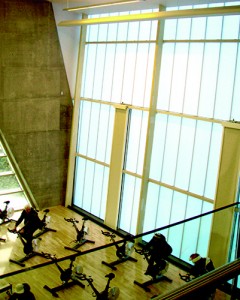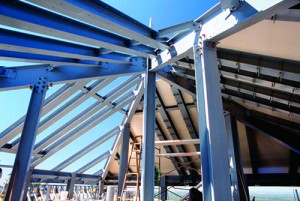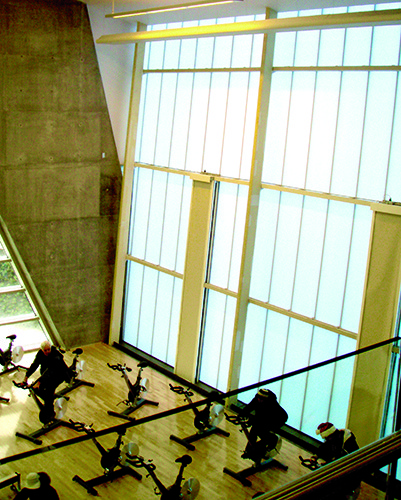Plastics are quickly becoming one of the most universal materials in construction and are being increasingly embraced by architects and engineers because of the extensive varieties available and their ability to be easily molded, formed and finished. Despite the industry offering the most innovative engineered building materials today, plastics are still in the early stages of understanding in terms of their potential.

“Following the pioneering plastic structures of the 1970s, a number of spectacular buildings have in recent years highlighted the outstanding technical and aesthetic potential of the material.”1 While sometimes overlooked as an alternative to traditional materials like wood or steel, the capabilities of plastics suggest their ability to reshape the way we think about traditional architecture and their use can bring new and creative structures to both indoor and outdoor designs.
The Big Picture
Next to packaging, the construction industry already ranks second for plastics consumption. Despite this, there is still a growth opportunity for plastics in commercial, industrial and residential construction. Currently vinyl represents the largest share of the market, occupying around 50% of the uses and applications, followed by polyethylene at 12%, and polypropylene at 7%.2 The most common applications for industrial plastics in architecture are fencing, siding, roofing, walls, decking, insulation, electrical coverings, and windows and frames leaving an array of purposes available for plastics especially as a structural component.
Green by Design
We may not traditionally think of plastics when we think of environmental design, however several advances in the technology, as well as new and creative design, have allowed for plastics to fit comfortably within the context of environmentally designed architecture.
Many of the plastics used in construction come from recycled materials, most notably vinyl, where the recycled material comes from in-house scrap. We are also seeing an increasing trend to source recycled plastic materials specifically for these uses.
Plastic building materials bring with them a host of advantages over more traditional materials, such as lower greenhouse gas emissions and increased energy efficiency over their lifespan. Plastics are both durable and effective, which has allowed the material to meet the latest LEED (Leadership in Energy and Environmental Design) standards in many cases, and make a significant contribution to the design of green architecture.
“Gains in energy efficiency gains, advances in building safety and reductions in carbon footprints wouldn’t be possible without the products of chemistry,” quoting American Chemistry Council (ACC) President and CEO Cal Dooley.3
The use of plastics in buildings and structural design saves energy, reduces cost, enhances quality of life, and helps protect the environment. Plastic applications also tend to be easy to install and require minimal maintenance. In addition, they take very minimal additional energy consumption, and minimal resources are needed for their continued effectiveness over the long term.
The ACC and the American High-Performance Buildings Coalition (AHPBC) as well as many other members of the plastics industry have been working hard to educate designers, engineers and architects on the environmental benefits of plastics and in August of 2014, the ACC and the U.S. Green Building Council (USGBC) announced that they will be working together on a new initiative that applies science-based approaches to the LEED building program. USGBC has established a working group made up of ACC staff, experts from ACC member companies and USGBC experts who will discuss how building materials are addressed in LEED.
Ann Kolton, the ACC’s vice president of communication stated in an interview with Plastic News, “Over time it became apparent something could be gained by combining our expertise in building materials, science and technology, and their expertise in sustainability and green buildings. We really do both have very similar goals. This is an effort to try to bring those unique areas of expertise together and share information and try to develop approaches that are science-based and incorporate life-cycle analysis as well as sustainability.” 3
These initiatives paired with the discovery of new plastic formulas and products with sustainability in mind make the future of plastics and its relationship with the environment a very positive one.
Building and Design Solutions

Plastics take the place of many traditional materials as an affordable and environmentally conscious material. Polycarbonate interior and exterior wall panels for example, have been used everywhere from hospitals, schools, restaurants, retail space, gyms, resorts, and car washes for both aesthetic and functional purposes. FRP wall panels are also easy to clean, and keep drywall from getting wet or damaged. This allows for an increased lifespan of drywall material, and also prevents mold and fungus from growing in wet environments. These panels in both interior and exterior applications will allow for minimal upkeep, and will continue to function to their full potential for decades.
Plastics can be found across a range of applications in the building sector because of their affordability, quality, and energy saving properties. Their versatility is such that the materials can be found in both home building and commercial applications from floor to ceiling, and everywhere in between.
Structural Solutions
In many environments, the maintenance costs of wood and steel have caused progressive designers to go looking for a more cost-effective, long-term materials. Wood rots and needs treatment regularly. Steel rusts and also needs regular treatment, especially in climates with heavy rainfall or on coastal buildings and structures. Plastics bring a solution to the drawbacks of these materials.
Fiberglass reinforced plastic (FRP), for example, has significant structural and architectural advantages over wood. Unlike timber and steel, FRP does not decay or rust and is not susceptible to insect attack. It never needs to be repainted, and is lightweight for easy installation. FRP shapes are also stronger and more rigid than timber, making them the preferred choice in newer structural designs and architecture including towers, platforms, wall supports and bridges.
Plastic grating systems have also replaced wood and steel in many applications. FRP grating is now commonly used in marinas and as walkways in mills, mines, institutions, and recreational locations.
Conclusion
The increased use of plastics in structural and architectural applications has come hand in hand with builders and designers looking for custom solutions that will out-perform other materials in the unique applications that they require. Plastics have firmly proven themselves to be an unbeatable material when it comes to building solutions, environmental performance, decreased maintenance costs, and creative custom design.
As an affordable, quality, energy-saving material, the versatility, performance, and aesthetic of plastics have allowed them to become an unbeatable material in architectural design and are only liable to increase in popularity as the industry challenges itself with demanding and revolutionary projects.
1Stephan Engelsmann. “Plastics: In Architecture and Construction”. Walter De Gruyter Incorporated, 2010
2 Marion Axmith is Director General, CPIA. “Green Building with Plastics”. SAB Magazine. December 18, 2008
3 Catherine Kavanaugh “Truce? ACC, US Green Building Council agree to work together on LEED”. August 28, 2014

